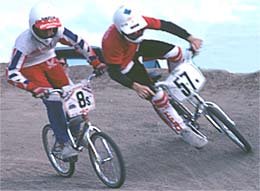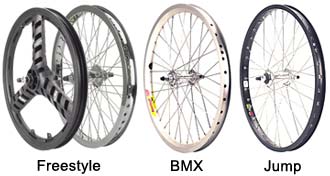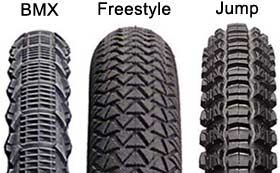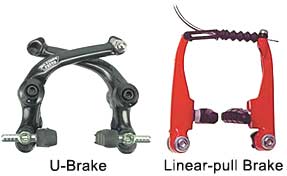How To Pick The Right BMX Bike
 Whether you're looking for yourself, or someone else, answering several questions makes choosing the right type of BMX bike much easier. Do you want to race? Do you insist on a lightweight frame and parts? Are you going to be stalking the streets or diggin' in the dirt? Will your playground be the local skatepark, BMX track or your buddy's backyard ramps? Thinking about these things and having a good idea about what you want and where you'll ride, will ensure you get the right BMX bike.
Whether you're looking for yourself, or someone else, answering several questions makes choosing the right type of BMX bike much easier. Do you want to race? Do you insist on a lightweight frame and parts? Are you going to be stalking the streets or diggin' in the dirt? Will your playground be the local skatepark, BMX track or your buddy's backyard ramps? Thinking about these things and having a good idea about what you want and where you'll ride, will ensure you get the right BMX bike.
Because people often throw around the "BMX" term generically, it's important to also understand that there are three different types of BMX bikes: the true BMX bike, the freestyle bike and the dirt jumper or just "jump" bike.
What's the difference between all these different types of BMX bikes. That's what we're here to explain. Nothing beats checking out these great bikes in person, too. After you've read this article, come into our shop and check 'em out!
20-Inch Bike Types
|
Type |
Description |
Features |
Ideal Use |
|
BMX |
A dirt-ready race bike |
Knobby tires, lightweight frame and parts, strong rear brake |
Dirt-track racing, going fast off road for short distances |
|
Freestyle |
A super-sturdy stunt and trick bike |
Ultra-beefy frame and wheels, pavement-ready tires, cable-detangling headset, axle pegs |
Riding at skateparks, learning and performing stunts and tricks |
|
Jump |
Sometimes called a Dirt Jumper, these are essentially a fusion of BMX and freestyle bikes |
Sturdy frame and wheels, rear brake, knobby tires |
Carving local trails, jumping ramps in your friend's back yard |
BMX: True BMX bikes started it all, back in the late sixties. They were knockoffs of motocross motorcycles and were designed for racing over jumps and around berms in the dirt. Pretty soon kids everywhere had them, racers or not. BMX bikes are still designed for racing, although you don't have to race to enjoy the light weight, speed and dirt worthiness of these machines. They usually have 20-inch wheels (24-inch-wheel "cruisers" are the exception), knobby tires, upright handlebars with crossbars, small saddles, long cranks and rear hand brakes. The frames are light and sturdy, and the higher the price, the lighter they get.
BMX bikes are generally made of chromoly steel or aluminum. Chromoly frames are a bit heavier and more economical. Aluminum frames are lighter and are often made of oversize or exotically shaped tubing. Besides weighing less, aluminum is also rustproof. So, if you scratch your frame, there's no need to rush to touch it up.
BMX bikes also come in different frame sizes. Our chart below shows the approximate fit based on rider age. Final fitting is best performed in our store. Also, the Pro and Expert bikes are sometimes available in XL (Extra Long) sizes as well.
|
Size |
Description |
Fits |
|
Mini |
Low standover height, 155-mm cranks, 20 x 1 1/8" tires |
4 to 6 years old |
|
Junior |
Slightly larger frame than Mini, 165-mm cranks, 20 x 1 3/8" tires |
6 to 9 years old |
|
Expert |
Longer top tube than Junior, 170-mm cranks, 20 x 1.5-1.75" tires |
9 to 13 years old |
|
Pro |
"Full-size" frame, 175-180-mm cranks, 20 x 1.75-2.2" tires |
12 and up |
Freestyle: These entered the scene shortly after BMX bikes. Rather than racing, the freestyle bike's ideal use is for flatland tricks, aggressive street riding and getting vertical at skateparks. It's also a great bike for riding to school, the store and the pool. Super-sturdy construction is a higher priority than light weight. The wheels are usually either "mag" wheels made of sturdy nylon (far left in the photo below), or heavy-duty models with 48 wire spokes. The tires are 20 x 2.125 or wider, with fairly smooth treads, because they're predominantly pavement pounders. Axle pegs are often included (riders stand on them for stunts), although some manufacturers leave them off so you can choose your own. Freestyle bikes come with front and rear brakes. The front cable is routed through a "rotor" or "detangler," which allows the handlebars to be spun completely around without tangling the brake cable.
Dirt Jumper: As the name implies, dirt jumpers (also known as jumpers) are designed for taking flight. They also bridge the wide gap between BMX bikes and freestylers (beefier than the former; lighter than the latter). They usually don't have front brakes and their brawny wheels normally feature 36 rugged 13-gauge spokes, rather than resorting to 48 spokes the way freestyle bikes do. They are occasionally equipped with 24-inch wheels, which are a great choice for larger riders. The tires are the most heavily treaded of any of the BMX types.
Equipment Choices
There are some important parts choices to make when purchasing a BMX bike:
 Wheels: It's crucial that the wheels meet your needs. Because accelerating out of starting gates is important in BMX, the wheels are much lighter than those found on freestyle or jump bikes. However, that 32-spoke light aluminum wheelset designed for BMX racing won't hold up to dirt jumping or ramping. So, freestyle bikes come almost exclusively with 48-spoke or mag wheels. This makes them ultra-beefy for maximum rim protection. Dirt jumper's wheels tend to be a bit more varied. Some dirt jumpers are equipped with just 36 super-meaty 13-gauge spokes. Others come with 48 spokes like freestyle bikes, depending on whether the bike is geared more for jumping or dirt riding. It's also important to note that the skinnier BMX tire and rim sizes (20 x 1 1/8-3/8 and 24 x 1 1/8-3/8) are not interchangeable with each other or with the 20 x 1.5 or 1.75 tire and rims.
Wheels: It's crucial that the wheels meet your needs. Because accelerating out of starting gates is important in BMX, the wheels are much lighter than those found on freestyle or jump bikes. However, that 32-spoke light aluminum wheelset designed for BMX racing won't hold up to dirt jumping or ramping. So, freestyle bikes come almost exclusively with 48-spoke or mag wheels. This makes them ultra-beefy for maximum rim protection. Dirt jumper's wheels tend to be a bit more varied. Some dirt jumpers are equipped with just 36 super-meaty 13-gauge spokes. Others come with 48 spokes like freestyle bikes, depending on whether the bike is geared more for jumping or dirt riding. It's also important to note that the skinnier BMX tire and rim sizes (20 x 1 1/8-3/8 and 24 x 1 1/8-3/8) are not interchangeable with each other or with the 20 x 1.5 or 1.75 tire and rims.
Tires: BMX tires straddle the line between pavement and dirt designs. Although they're used mostly off road, the tracks are often hard-packed dirt where low rolling resistance is important. The tread has to provide optimum speed and traction and grip when you're cornering and accelerating. Freestyle tires are designed for pavement and indoor surfaces. Premium tires often inflate to higher pressures as well, lowering rolling resistance, increasing rim protection and decreasing tire deflection when the sidewalls are placed under high loads such as during landings. Dirt jumpers are usually designed for maximum traction. Since speed isn't important and the conditions aren't as controlled, their lugs are a bit beefier.

Handlebars: Beside weight and strength differences, there is also a subtle difference in handlebar shape between the BMX bar and the others. Freestyle and jump bars tend to rise steeper from the clamping area to give the rider better freedom of movement while performing flatland and airborne maneuvers. Also, bars found on 24-inch BMX and jumpers will be slightly shorter in rise than those found on 20-inch bikes.
Brakes: Freestyle bikes come with front and rear brakes. BMX and jump bikes usually sport only rear brakes. Brake type is also important. BMXers require pure stopping power so they prefer linear-pull brakes, which offers the ultimate grip. Freestylers are more interested in control than grip and they prefer U-brakes front and rear. Although U-brakes don't offer the stopping power of linear pulls, they offer better modulation, so they work like dimmer switches, where linear pulls are more like on/off switches.

We hope this overview helps you pick out a great new bike. Browse our website to get a feel for the great BMX models we offer and be sure to visit our real store soon so we can show you some of these amazingly fun bikes up close and personal. Happy shopping!
